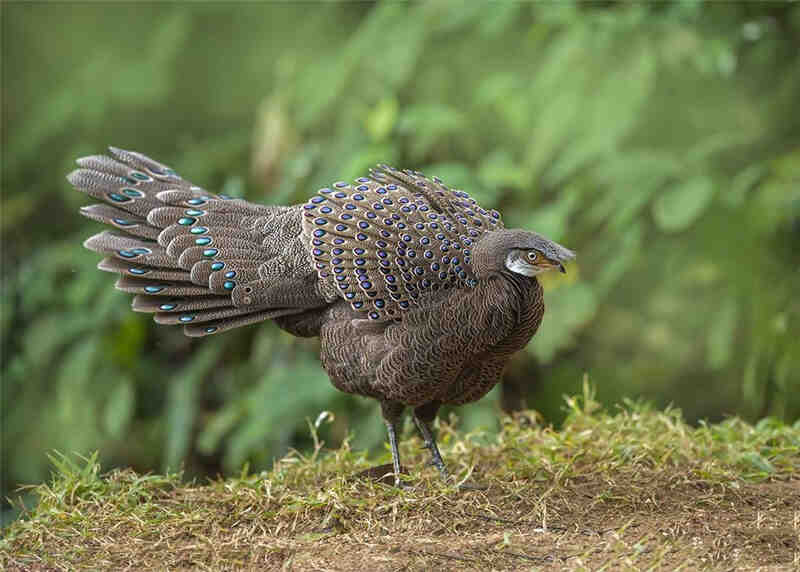Polyplectron katsumatae
IUCN
LCBasic Information
Scientific classification
- name:Polyplectron katsumatae
- Scientific Name:Polyplectron katsumatae,Hainan Peacock-pheasant
- Outline:Landfowl
- Family:Chickeniformes P.family Pheasant
Vital signs
- length:33-70cm
- Weight:456-710g
- lifetime:No textual research information is available
Feature
It is one of the rare and endangered pheasant species, and the male adult bird resembles the gray peacock named subspecies, but is much smaller
Distribution and Habitat
Hainanese Peacock pheasant is an endemic species distributed in Hainan Island, China. It is very rare and is found in the only remaining mountain forests in the southwest of Hainan Island. After a long period of independent evolution, the status of the gray peacock pheasant distributed in Hainan has been upgraded from an endemic subspecies to an independent species, and its name has also been changed from the gray Pored pheasant to the Hainan Peacock Pheasant.
Its main distribution areas in Hainan Province are Bawangling, Jianfengling, Xiaoluo Mountain and Limu Mountain and other well-protected primitive forest areas. In addition, the trace of Hainan peacock pheasant has also been recorded in Jiaxin in the southeast, Chengmai in the north central, Nanweiling in Tunchang and Liulianling.
It inhabits evergreen broad-leaved forests and bamboo groves at an altitude of 150-1500 meters. The use of the activity area is very stable, and the activity area is small. This is the result of a
Appearance
cock
Body length 50-67 cm, weight 456-710 g. Upper body all mostly black brown; The head has a shaggy and elongated hairlike crown, mixed with nearly white dots; The hind neck is covered with a feather collar, black brown, with brownish white stripes; Dorsal feathers are also dark brown, with nearly white larger spots; Below the back, there are both near white spots and transverse spots; The surface of the two wings is the same color as the back, and the back has metallic greenish-blue with purple eye spots, each spot is surrounded by a narrow black-brown circle and a wider white circle; Primary feather pure black brown, only a slight hazel thin point; The tail feathers are the same color as the back, but the white spots are larger, and there are pairs of eye spots about 20-30 mm from the tail, these spots are about 1-2 times larger than the back, and are greener. Chin and throat white; The chest and the flanks and the nape of the neck are similar; The rest of the lower body is simi
Details
Hainan Peacock pheasant has no subspecies.

Hainanese pheasants often move alone or in pairs, and will flee if disturbed. It rarely rises to the top of the tree and burrows into the dense branches. They perch on branches at night. Travel alone or in pairs, forage on the ground and spend the night in the trees. The peacock pheasant takes animal food as its main food, and eats almost all insects and worms, which is rare among pheasants. The male bird's call is loud and pleasant, and it will emit a guang-gui, guang-gui two one-degree calls, the first one is longer. The female makes a fast call called ga.ga.ga.
Hainan peacock pheasant begins to breed from late February to early March. More nesting in dense forest gully land and mountain farmland near the secondary forest, the nest in the natural concave ground. Breeding in March to May, laying 2-5 eggs per nest, incubation period of 21 days.
In 2004, the Hainan Provincial Forestry Bureau, Hainan Normal University and Beijing Normal University jointly studied through DNA sequencing and molecular genetic markers, and found that the genetic distance between Hainan peacock pheasant and gray peacock pheasant was 3.1%, which exceeded the range of genetic distance between bird species and species level, and should be independent species. According to a paper published in Zoological Science (Zoological Science) in 2008, after a long period of independent evolution, the genetic distance between Hainan peacock pheasant and gray peacock pheasant has become wider and wider in the past millions of years, and about 4.4 to 6 million years ago, it diverged into an independent species.
The Hainanese Peacock pheasant is a very rare species of chicken. Due to the destruction of secondary deciduous monsoon rainforest and evergreen monsoon rainforest habitats, its distribution area is rapidly disappearing and retreating. A common predator is the weasel, while daytime birds of prey also kill peacock pheasants. Human hunting poses a great threat to the peacock pheasant, which is already in a very endangered situation.
Listed on the International Union for Conservation of Nature Red List of Threatened Species (IUCN) in 2016 ver 3.1 - Endangered (EN).
Listed in China's "National Key Protected Wildlife List" (February 5, 2021).
On April 23, 2022, it was selected into the list of priority protected species of Hainan Tropical Rainforest National Park.
Protect wild animals and eliminate wild meat.
Maintaining ecological balance is everyone's responsibility!








